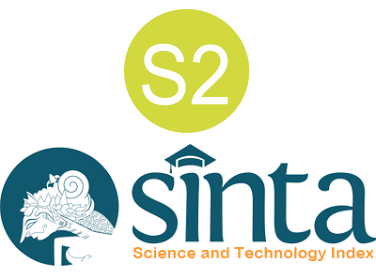Kala Tatwa Dan Realisasinya Terhadap Keberagamaan Masyarakat Hindu Di Bali
DOI:
https://doi.org/10.37329/jpah.v9i4.3525Keywords:
Bhatara Kala, Religion, Hindu SocietyAbstract
Bhatara Kala is commonly perceived by the general public as a terrifying, evil, and monstrous figure. However, according to the Kala Tatwa palm-leaf manuscript, Bhatara Kala is the son of Bhatara Siwa and Bhatari Giri Putri, symbolizing the manifestation of the Panca Maha Bhuta (Akasa, Apah, Teja, Bayu, Pertiwi), representing both time and cosmic energy. This study aims to deepen faith (sradha) and devotion (bhakti) to the Supreme God, and to understand the concept of kala (time) and its realization within the religious practices of the Balinese Hindu community. The research adopts a semi-literature and field-based approach, utilizing data collection methods such as observation, hermeneutics, literature review, document study, and data analysis through reduction, textual criticism, and data presentation techniques. The findings reveal that Bhatara Kala is interpreted as a symbol of time and energy that governs all existence and cannot be stopped. In Balinese Hindu belief, time is sacred and serves as the foundation for determining auspicious days (dewasa ayu) for performing religious rituals, such as Dewa Yadnya, Manusa Yadnya, Rsi Yadnya, Pitra Yadnya, and Bhuta Yadnya. The belief in Bhatara Kala reflects the community’s profound understanding of time, space, and transformation (Desa, Kala, Patra), ensuring that every spiritual activity aligns harmoniously with cosmic rhythms and the natural world.
References
Bagus, L. (2000). Kamus Filsafat. Jakarta: Gramedia Pustaka Utama.
Brahman, I M. A. (2016). Teologi Hindu dalam Bhagawad-Gītā (Perspektif Teologi Deterministik). Dalam Prosiding Seminar Nasional Institut Hindu Dharma Negeri Denpasar. Denpasar, Indonesia: IHDN Denpasar.
Dewi, I. A. P. M. P., Suwedawati, G. A. K. A., & Sepriani, N. K. (2023). Peningkatan Karakter Sradha Dan Bhakti Anak Golden Age Melalui Pembuatan Yadnya Sederhana. Metta: Jurnal Ilmu Multidisiplin, 3(2), 232-244.
Fatchan. (2004). Teori-Teori Perubahan Sosial. Surabaya : Yayasan Kampusina
Gaduh, A. W., & Harsananda, H. (2021). Teo-Ekologi Hindu Dalam Teks Lontar Sri Purana Tatwa. Kamaya: Jurnal Ilmu Agama, 4(3), 426-441.
Jalaludin. (2002). Psikologi Agama. Jakarta: Grafindo Persada
Kananda, F. V., Sudarsana, I. K., & Putri, I. D. A. H. (2024). Implementasi Kebijakan Merdeka Belajar Pada Mata Pelajaran Pendidikan Agama Hindu Dan Budi Pekerti Di Sekolah Vidya Karuna Ubung Kaja Denpasar. Kamaya: Jurnal Ilmu Agama, 7(4), 49-60.
Mulyono, E. (2012). Belajar Hermeneutika. Banguntapan, Yogyakarta: IRCiSoD.
Novitasari, A. (2022). Manfaat Yoga Bagi Kesehatan Mental Pada Remaja. Metta: Jurnal Ilmu Multidisiplin, 2(4), 250-263.
Pandeyana, I. K. M., & Dharma, I. B. G. R. O. (2024). The Concept Perspective of Karmaphala as The Law of Cause and Effect in The Pillars of Hindu Religious Beliefs. International Journal of Multidisciplinary Sciences, 2(3), 310-320.
Paramita, A. A. G. K. (2021). Ajaran Satvika Yadnya Sebagai Konsep Pendidikan Menuju Kesejahteraan Umat Dalam Beragama Sosial. Kamaya: Jurnal Ilmu Agama, 4(2), 166-176.
Poespoprodjo. (2004). Hermeneutika. Bandung : Pustaka Setia
Rema, N. (2017). Dewa Tertinggi Siwa-Buddha: Studi Etno-Arkeologi. Forum Arkeologi, 25(1), 81-94.
Robertson, R. (1993). Agama dalam Analisa dan lnterpretasi Sosiologis. Jakarta: Rajawali Pers
Robertson, R. (1995). Agama Dalam Analisisa Dan Interpretasi Sosiologis. Jakarta: Raja Grafindo Persada
Santosa, I. K. E., Sudarsana, I. K., & Dewi, N. P. C. P. (2025). Pemanfaatan Kecerdasan Buatan Dalam Pembelajaran Sekolah Dasar Kesiapan Guru Dan Implikasi Etis. JPGI (Jurnal Penelitian Guru Indonesia), 10(1), 80-84.
Saputra, I. K. B. D. (2022). Nitisastra Sebagai Pedoman Seorang Pemimpin Membina Generasi Muda Sekaa Teruna. Metta: Jurnal Ilmu Multidisiplin, 2(1), 1-10.
Sudarsana, I. K. (2024). Ethical Education Values in Balinese Women’s Traditional Clothing. Cetta: Jurnal Ilmu Pendidikan, 7(4), 170-180.
Sumertini, N. K., & Sutresna, I. M. (2024). Development Of Hindu Character Values Education For Early Childhood. International Journal of Multidisciplinary Sciences, 2(4), 451-460.
Surada, I M.. (2004). Pendidikan Tatwa Agama Hindu. Denpasar : STAHN Denpasar
Titib, I M. (2003). Teologi Dan Simbol-simbol Dalam Agama Hindu. Surabaya: Paramita
Yasa, I. W. S., Sumadi, I. K., & Sukabawa, I. W. (2025). Implementation of The Tri Hita Karana Concept in Environmentally Friendly Resource Management: A Study of Solar Power Plants in Nusa Penida. International Journal of Multidisciplinary Sciences, 3(1), 109-118.
Yendra, I. W. (2009). Kanda Empat Dewa: Manusia Setengah Dewa Sakti Manderaguna. Surabaya: Pāramita.
Downloads
Published
How to Cite
Issue
Section
License
Copyright (c) 2025 Gede Rai Parsua

This work is licensed under a Creative Commons Attribution-ShareAlike 4.0 International License.
An author who publishes in the Jurnal Penelitian Agama Hindu agrees to the following terms:
- Author retains the copyright and grants the journal the right of first publication of the work simultaneously licensed under the Creative Commons Attribution-ShareAlike 4.0 License that allows others to share the work with an acknowledgement of the work's authorship and initial publication in this journal
- Author is able to enter into separate, additional contractual arrangements for the non-exclusive distribution of the journal's published version of the work (e.g., post it to an institutional repository or publish it in a book) with the acknowledgement of its initial publication in this journal.
- Author is permitted and encouraged to post his/her work online (e.g., in institutional repositories or on their website) prior to and during the submission process, as it can lead to productive exchanges, as well as earlier and greater citation of the published work (See The Effect of Open Access).
Read more about the Creative Commons Attribution-ShareAlike 4.0 Licence here: https://creativecommons.org/licenses/by-sa/4.0/.








